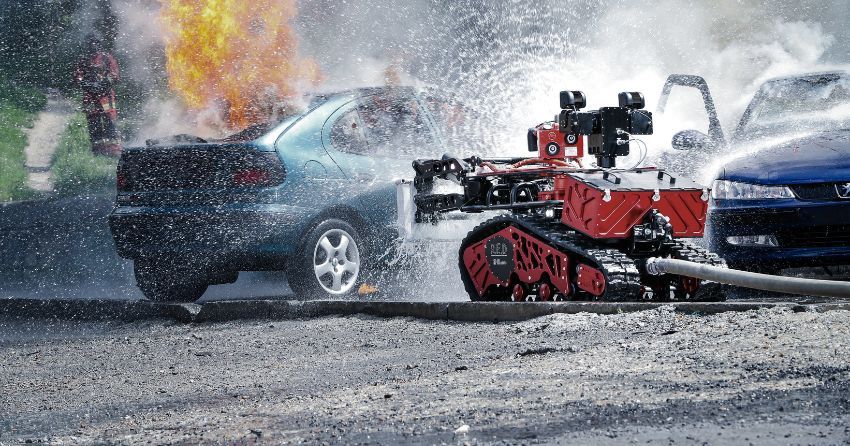Why parking garage fire safety matters more than ever
05/27/2025
As modern vehicles evolve, so do the fire risks associated with them. The increasing use of lithium-ion batteries, high-pressure fuel systems, and plastic components has created new challenges for fire safety, particularly in enclosed spaces like parking garages. Fires in these environments can spread rapidly, releasing toxic smoke and potentially compromising the structural integrity of the building. While fire suppression systems and safety regulations have adapted to some extent, gaps remain in prevention, preparedness, and emergency response strategies. Innovations such as firefighting robots and AI-powered early detection systems are emerging as critical tools in mitigating these risks.
UNDERSTANDING THE CAUSES OF CAR PARK FIRES
Modern vehicle risks
New generation vehicles present unique fire risks due to advancements in materials, propulsion systems, and design. One of the most significant concerns is the potential for lithium-ion battery fires in electric and hybrid cars. These batteries can experience thermal runaway, a self-sustaining reaction that generates extreme heat and can lead to explosions. They are also vulnerable to short circuits, impact damage, and charging malfunctions, with some fires reigniting hours or even days after being extinguished. Additionally, the increased use material like plastics in cars construction, while beneficial for weight reduction, raises flammability risks, as these materials can burn rapidly and release toxic fumes. High-pressure fuel systems in gasoline, diesel, and hydrogen-powered vehicles also pose hazards, with leaks potentially leading to intense fires. Moreover, the growing complexity of electrical systems increases the likelihood of short circuits, while flammable insulation and cabin materials can contribute spreading. Fire suppression is particularly challenging in electric cars, as traditional firefighting methods may be ineffective, requiring specialized techniques like battery submersion.
Structural challenges
Outbreaks in parking facilities present multiple challenges, particularly due to their enclosed design, which accelerates heat buildup and intensifies fire conditions. While ventilation might seem beneficial, it can actually fuel the blaze by increasing oxygen flow, leading to faster fire growth. Underground and enclosed parking garages further complicate firefighting efforts, as heat, smoke, and toxic fumes become trapped, reducing visibility and making intervention more hazardous. Another growing concern is the use of automated car stackers, which, while optimizing space, increase the risk of fire spread between tightly packed vehicles. Additionally, mechanical failures in these systems can hinder emergency responders from accessing or repositioning burning cars. These structural complexities emphasize the need for advanced fire suppression technologies, strategic ventilation management, and updated safety protocols to better address fire risks in modern parking facilities. In addition to these structural challenges, firefighters often face significant accessibility issues in parking facilities. Narrow ramps, low ceiling clearances, and tight turning radii can prevent fire trucks from entering or navigating within these spaces. As a result, responders must carry heavy equipment manually over long distances, which delays intervention and increases physical strain.
THE CHALLENGES OF FIRES IN UNDERGROUND CAR PARKS
Rapid fire spread and intensity
Fires in underground car parks present unique challenges due to rapid fire spread and high-intensity flames, particularly with the presence of lithium-ion batteries in electric vehicles. The proximity of parked cars allows fires to spread quickly; in just 10 minutes, flames can engulf the neighboring vehicle. According that firefighters need around 20 minutes from the emergency call to active intervention, by the time they arrive on the scene, at least five cars could already be burning, making containment significantly harder. A striking example occurred at Luton Airport in London, where a major blaze broke out in an elevated parking structure, rapidly consuming multiple vehicles. The intensity of the fire forced authorities to suspend flights, highlighting the widespread disruption and economic impact that such incidents can cause.
Toxic smoke and structural damage
Fires involving modern vehicles not only pose direct risks but also have severe secondary consequences. One of the most critical issues is the dense, toxic smoke that can quickly spread beyond the immediate fire zone, affecting nearby businesses and residences. Burning plastics, batteries, and synthetic materials release hazardous fumes that can compromise air quality and pose serious health risks. Parking spaces are full of different combustible materials making smoke control even more difficult. Additionally, intense fires can lead to structural impairments, especially in enclosed spaces such as garages, where extreme heat may weaken concrete, steel reinforcements, and support structures, increasing the risk of partial or total collapse. This is what happened in Aubervillier in april 2023, a fire broke out in parking lot causing the concrete slab above to suddenly collapse due to the intense heat, narrowly avoiding a tragedy. This incident highlights the structural vulnerabilities of such infrastructures and the critical need for fire-resistant designs
CURRENT SOLUTIONS AND GAPS
Fire suppression systems
Modern structures rely heavily on fire suppression systems, particularly sprinklers, to contain fires before they spread. However, existing fire safety regulations, such as NFPA guidelines, are being reassessed to address the unique challenges posed by electric vehicles (EVs), which burn hotter and longer than traditional internal combustion engine fires. While sprinklers help control flames, they often prove insufficient against high-intensity battery fires, highlighting the need for adjusted fire safety standards and innovative suppression solutions. Prevention and preparedness Mitigating fire risks starts with proper EV management, including strategic vehicle spacing, controlled charging stations, and specialized battery handling procedures. Parking garages must also evaluate existing safety protocols to identify vulnerabilities, such as inadequate ventilation, outdated suppression systems, and a lack of staff training for EV-related fire emergencies. By addressing these gaps, facility managers can reduce the likelihood of catastrophic fires and improve overall response effectiveness.
THE ROLE OF INNOVATIONS IN FIREFIGHTING
Firefighting robots as game changers
As fire risks evolve, so do firefighting solutions. Robotic systems, such as those developed by Shark Robotics, are transforming emergency response by enhancing safety and efficiency in high-risk scenarios. These autonomous or remotely operated machines can navigate hazardous environments, withstand extreme temperatures, and apply targeted suppression efforts, reducing risks for human firefighters. The effectiveness of such technology was demonstrated in real-world incidents, including the Notre-Dame Cathedral fire, where robotic intervention played a crucial role in containing the blaze without endangering lives. Leveraging technology for better outcomes Beyond robotics, early detection systems and advanced fire suppression mechanisms are critical in minimizing fire damage. AI-powered sensors can identify temperature anomalies and trigger early warnings, enabling faster response times. Additionally, stronger collaboration between insurance providers, safety experts, and technology developers is essential in shaping modern fire prevention strategies, ensuring that facilities adopt cutting-edge solutions before disasters occur. This is why Shark Robotics is currently developing autonomous robots capable of containing and extinguishing fires in enclosed spaces like parking lots. This represents a major technological breakthrough, reducing critical fire hazards by enabling faster response between detection and firefighter intervention.
RECOMMENDATIONS FOR SECURING CAR PARKS
Actionable steps for parking managers
With fire risks evolving, parking facility managers must implement preventive measures specifically designed for modern vehicle threats. This includes ensuring compliance with updated fire safety standards, adopting best practices for EV parking and charging, and integrating real-time monitoring systems. Regular staff training and emergency drills further enhance preparedness, ensuring a swift and coordinated response in case of fire.
Encouraging investment in firefighting innovations
To future-proof parking structures, investing in firefighting technologies—such as firefighting robots, enhanced suppression systems, and intelligent monitoring tools—is essential. These innovations offer rapid and efficient fire response, minimizing damage and protecting both people and property. While the initial costs may seem significant, long-term savings from reduced damage, lower insurance premiums, and improved safety protocols make these investments highly beneficial. By addressing fire risks with proactive solutions, advanced technologies, and strategic planning, parking facilities can significantly enhance safety, reduce financial losses, and contribute to a more resilient urban infrastructure.
Contact our communications team
